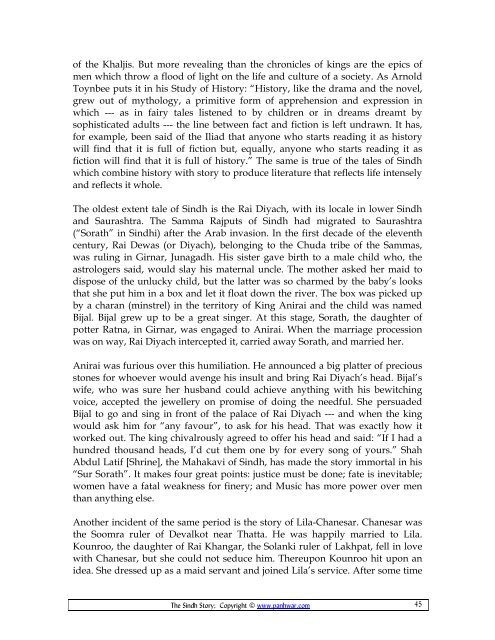Create successful ePaper yourself
Turn your PDF publications into a flip-book with our unique Google optimized e-Paper software.
of the Khaljis. But more revealing than the chronicles of kings are the epics of<br />
men which throw a flood of light on the life and culture of a society. As Arnold<br />
Toynbee puts it in his Study of History: “History, like the drama and the novel,<br />
grew out of mythology, a primitive form of apprehension and expression in<br />
which --- as in fairy tales listened to by children or in dreams dreamt by<br />
sophisticated adults --- the line between fact and fiction is left undrawn. It has,<br />
for example, been said of the Iliad that anyone who starts reading it as history<br />
will find that it is full of fiction but, equally, anyone who starts reading it as<br />
fiction will find that it is full of history.” The same is true of the tales of Sindh<br />
which combine history with story to produce literature that reflects life intensely<br />
and reflects it whole.<br />
The oldest extent tale of Sindh is the Rai Diyach, with its locale in lower Sindh<br />
and Saurashtra. The Samma Rajputs of Sindh had migrated to Saurashtra<br />
(“Sorath” in Sindhi) after the Arab invasion. In the first decade of the eleventh<br />
century, Rai Dewas (or Diyach), belonging to the Chuda tribe of the Sammas,<br />
was ruling in Girnar, Junagadh. His sister gave birth to a male child who, the<br />
astrologers said, would slay his maternal uncle. The mother asked her maid to<br />
dispose of the unlucky child, but the latter was so charmed by the baby’s looks<br />
that she put him in a box and let it float down the river. The box was picked up<br />
by a charan (minstrel) in the territory of King Anirai and the child was named<br />
Bijal. Bijal grew up to be a great singer. At this stage, Sorath, the daughter of<br />
potter Ratna, in Girnar, was engaged to Anirai. When the marriage procession<br />
was on way, Rai Diyach intercepted it, carried away Sorath, and married her.<br />
Anirai was furious over this humiliation. He announced a big platter of precious<br />
stones for whoever would avenge his insult and bring Rai Diyach’s head. Bijal’s<br />
wife, who was sure her husband could achieve anything with his bewitching<br />
voice, accepted the jewellery on promise of doing the needful. She persuaded<br />
Bijal to go and sing in front of the palace of Rai Diyach --- and when the king<br />
would ask him for “any favour”, to ask for his head. That was exactly how it<br />
worked out. The king chivalrously agreed to offer his head and said: “If I had a<br />
hundred thousand heads, I’d cut them one by for every song of yours.” Shah<br />
Abdul Latif [Shrine], the Mahakavi of Sindh, has made the story immortal in his<br />
“Sur Sorath”. It makes four great points: justice must be done; fate is inevitable;<br />
women have a fatal weakness for finery; and Music has more power over men<br />
than anything else.<br />
Another incident of the same period is the story of Lila-Chanesar. Chanesar was<br />
the Soomra ruler of Devalkot near Thatta. He was happily married to Lila.<br />
Kounroo, the daughter of Rai Khangar, the Solanki ruler of Lakhpat, fell in love<br />
with Chanesar, but she could not seduce him. Thereupon Kounroo hit upon an<br />
idea. She dressed up as a maid servant and joined Lila’s service. After some time<br />
The Sindh Story; Copyright © www.panhwar.com<br />
45


